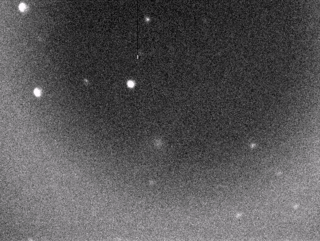I made the loop above from a number of CCD frames that I took on the night of the collision. The telescope used was the 14 inch S/C at the Pima College East Campus Observatory, Tucson, Az. The comet is the "star like" object that is moving downward toward the left of the frame. If you look closely, just before it repeats, you can just see a slight bright dot appear at the top of the comet. That was the impact!
Here is a NASA description of what was to happen during the collision:
A NASA spacecraft named Deep Impact is going to shoot an 820-pound projectile into the rocky, icy nucleus of Comet Tempel 1. The 23,000 mph collision will form a big crater, and Deep impact will observe the stages of its development, how deep it gets and how wide it becomes. Researchers expect a plume of gas and dust to spray out of the crater. Deep Impact will measure its composition and record what the billowing plume does to the comet's atmosphere. In all, Deep Impact should be able to peer into the new crater for almost 15 minutes before the craft speeds away, continuing, like its cometary quarry, to orbit forever around the Sun.

No comments:
Post a Comment